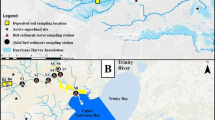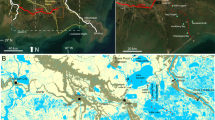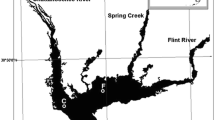Abstract
Coastal cities in tropical areas are often low-lying and vulnerable to the effects of flooding and storms. San Juan, Puerto Rico, is a good example of this. It is built around a lagoon-channel complex called the San Juan Bay Estuary (SJBE). A critical channel in the estuary, the Caño Martín Peña, has filled in and now frequently floods the surrounding communities with sewage-enriched waters, causing a series of human health and ecological problems. Sediment core analyses indicate that portions of the SJBE now function as settling basins. High urban and sewage runoff to the Caño contributes nitrogen (N), but stable isotope and sediment nutrient analyses indicate that this runoff may also enhance conditions for coupled sulfate reduction-nitrogen fixation. The amount of ‘new’ bioavailable N created from inert atmospheric N2 gas may meet or exceed that from the runoff into the Caño Martín Peña. The ecological consequences of this appear to extend beyond the ponded channel, potentially contributing to the poor water quality of the SJBE, greater than contaminated runoff alone.






Similar content being viewed by others
References
Appleby PG, Oldfield F. 1978. The calculation of lead-210 dates assuming a constant rate of supply of unsupported 210Pb to the sediment. CATENA 5:1–8.
Army Corps. 2004. Reconnaissance Report Section 905(b) (WDRA 86) Analysis Caño Martín Peña, Puerto Rico, Ecosystem Restoration. US Army Corps of Engineers, Jacksonville District.
Army Corps. 2016. Final Environmental Impact Statement Cano Martín Pena Ecosystem Restoration Project San Juan, Puerto Rico. Prepared by the Corporación del Proyecto ENLACE del Caño Martín Peña and its consultants Atkins Caribe, LLP, Atkins North America, and Estudios Técnicos, Inc., for review by the U.S. Army Corps of Engineers.
Aspila KI, Agemain H, Chau A. 1976. A semi-automated method for the determination of inorganic, organic and total phosphorus in sediments. Analyst 101:187–97.
Bhavya PS, Kumar S, Gupta GVM, Sudheesh V, Sudharma KV, Varrier DS, Dhanya KR, Saravanane N. 2016. Nitrogen uptake dynamics in a tropical eutrophic estuary (Cochin, India) and adjacent waters. Estuaries Coasts 39:54–67.
Blott SJ, Pye K. 2001. GRADISTAT: a grain size distribution and statistics package for the analysis of unconsolidated sediments. Earth Surf Process Landf 26:1237–48.
Bottcher ME, Khim B, Suzuki A, Gehre M, Wortmann UG, Brumsack H. 2004. Microbial sulfate reduction in deep sediments of the Southwest Pacific (ODP Leg 145 181, sites 1119–1125): evidence from stable sulfur isotope fractionation and pore water modelling. Mar Geol 205:249–60.
Brownlow AH. 1996. Geochemistry. 2nd edn. Englewood Cliffs, NJ: Prentice Hall. p 580.
Branoff B. 2019. Quantifying the influence of urbanization on Puerto Rico’s Mangrove Ecosystems. Ph.D. Dissertation, University of Puerto Rico, Río Piedras.
Brunner B, Contreras S, Lehmann MF, Matantseva O, Rollog M, Kalvelage T, Klockgether G, Lavik G, Jetten MSM, Kartal B, Kuypers MMM. 2013. Nitrogen isotope effects induced by anammox bacteria. Proc Natl Acad Sci 110:18994–9.
Bunch BW, Cerco CF, Dortch MS, Johnson BH, Kim KW. 2000. Hydrodynamic and Water Quality Model Study of San Juan Bay Estuary. ERDC TR-00-1, U.S. Army Engineer Research and Development Center, Vickburg, MS.
Canfield DE. 2001. Isotope fractionation by natural populations of sulfate-reducing bacteria. Geochim Cosmochim Acta 65(7):1117–24.
Cerco C, Bunch B, Dortch M, Johnson B, Kim K. 2003. Eutrophication and pathogen abatement in the San Juan Bay Estuary. J Environ Eng 129:318–27.
Ellis SR. 1976. History of dredging and filling of Lagoons in the San Juan Area, Puerto Rico. Prepared in cooperation with the Commonwealth of Puerto Rico, USGS Water Resources Investigations 76–38.
Emery D, Robinson A. 1993. Inorganic geochemistry: applications to petroleum geology. Oxford: Blackwell Scientific Publications. p 268.
Evermann BW. 1900. General report on the investigations in Porto Rico of the United States Fish Commission steamer Fish Hawk in 1899. Extracted from U.S. Fish Commission Bulletin for 1900. https://www.st.nmfs.noaa.gov/spo/FishBull/20-1/evermann1.pdf
Franco D. 2016. Puerto Rico community land trust awarded UN World Habitat Award. NBC News, February 29, 2016, https://www.nbcnews.com/news/latino/puerto-rico-community-land-trust-awarded-un-world-habitat-award-n528031.
Friedman GM, Sanders JE. 1978. Principles of sedimentology. New York: Wiley.
Fry B. 2006. Stable isotope ecology. New York: Springer.
Gray AB, Pasternack GB, Watson EB. 2010. Hydrogen peroxide treatment effects on the particle size distribution of alluvial and marsh sediments. Holocene 20:293–301.
Harris D, Horwáth WR, van Kessel C. 2001. Acid fumigation of soils to remove carbonates prior to total organic carbon or carbon-13 isotopic analysis. Soil Sci Soc Am J 65:1853–6.
Hartz, M. 2018. Why Hurricane Maria is no match for this mighty community in Puerto Rico. Forbes, March 19, 2018. https://www.forbes.com
Heiri O, Lotter AF, Lemcke G. 2001. Loss on ignition as a method for estimating organic and carbonate content in sediments: reproducibility and comparability of results. J Paleolimnol 25:101–10.
Holguin G, Vazquez P, Bashan Y. 2001. The role of sediment microorganisms in the productivity, conservation, and rehabilitation of mangrove ecosystems: an overview. Biol Fertil Soils 33:265–78.
Jean MRN, Gonzalez-Rizzo S, Gauffre-Autelin P, Lengger SK, Gros O. 2015. Two new Beggiatoa species inhabiting marine mangrove sediments in the Carribean. PLoS ONE 10:e0117832. https://doi.org/10.1371/journal.pone.0117832.
Lario J, Spencer C, Plater AJ, Zazo C, Goy JL, Dabrio CJ. 2002. Particle size characterisation of Holocene back-barrier sequences from North Atlantic coasts (SW Spain and SE England). Geomorphology 42:25–42.
Mendelsohn R, Emanuel K, Chonabayashi S, Bakkensen L. 2012. The impact of climate change on global tropical cyclone damage. Nat Clim Change . https://doi.org/10.1038/nclimate1357.
Montoya JP. 2007. Natural abundance of 15N in marine planktonic ecosystems. In: Michener R, Lajtha K, Eds. Stable iotopes in ecology and environmental science. Massachusetts: Blackwell Publishing. p 176–201.
Nelson DC, Waterbury JB, Jannasch HW. 1982. Nitrogen fixation and nitrate utilization by marine and freshwater Beggiatoa. Arch Microbiol 133:172–7.
Oczkowski A, Taplin B, Pruell R, Pimenta P, Johnson R, Grear J. 2018. Carbon stable isotope values in plankton and mussels reflect changes in carbonate chemistry associated with nutrient enhanced net production. Front Mar Sci . https://doi.org/10.3389/fmars.2018.00043.
O’Dally T. 1776. In Sepúlveda A. 2003. Caño de Martín Peña—El Proceso de Ocupación. Annex 2: Plan de Desarrollo Integral para el Distrito de Planificación Especial del Caño Martín Peña. Departamento de Transportación y Obras Públicas, Autoridad de Carreteras y Transportación.
O’Neil JM, Capone DG. 1989. Nitrogenase activity in tropical carbonate marine sediments. Mar Ecol Prog Ser 56:145–56.
Pait AS, Whitall DR, Dieppa A, Newton SE, Brune L, Caldrow C, Mason AL, Apeti DA, Christensen JD. 2012. Characterization of organic chemical contaminants in sediments from Jobos Bay, Puerto Rico. Environ Monit Assess 184:5065–75.
Pascal PY, Gros O, Boschker HTS. 2016. Temporal fluctuations in the trophic role of large benthic sulfur bacteria in mangrove sediment. Food Webs 7:20–8.
Pérez-Villalona H. 2014. Nutrient dynamics in the Laguna San José, a tropical urban lagoon in the San Juan Bay Estuary, Puerto Rico. Ph.D. Dissertation, University of Puerto Rico, Río Piedras.
Pérez-Villalona H, Cornwell JC, Ortiz-Zayas JR, Cuevas E. 2015. Sediment denitrification and nutrient fluxes in the San José Lagoon, a tropical lagoon in the highly urbanized San Juan Bay Estuary, Puerto Rico. Estuaries Coasts 38:2259–78.
Quiñones F, Green B, Santiago L. 1989. Sedimentation survey of Lago Loíza, Puerto Rico, July 1985. U.S. Geological Survey Water-Resources Investigations Report 87-4019 prepared in cooperation with the U.S. Department of Agriculture, Soil Conservation Service. https://pubs.usgs.gov/wri/1987/4019/report.pdf.
Romero IC, Jacobson-Meyers ME, Fuhrman JA, Capone DG. 2015. Phylogenetic diversity of diazotrophs along an experimental nutrient gradient in mangrove sediments. J Mar Sci Eng 3:699–719.
Sheffield PE, Rowe M, Agu D, Rodríguez LN, Avilés KR. 2014. Health impact assessments for environmental restoration: the case of Caño Martín Peña. Ann Global Health 80:296–302.
Stanchich M. 2017. People power in Puerto Rico: how a canal community escaped gentrification, January 18, 2018 https://www.theguardian.com/cities/2017/jan/18/people-power-puerto-rico-canal-community-escaped-gentrification.
Tanner WF. 1995. William F. Tanner on environmental clastic granulometry. Florida Geological Survey Special Publication 40, 163. https://ufdc.ufl.edu/UF00099455/00001.
Tucker J, Sheats N, Giblin AE, Hopkinson CS, Montoya JP. 1999. Using stable isotopes to trace sewage-derived material through Boston Harbor and Massachusetts Bay. Mar Environ Res 48:353–75.
van der Valk AG, Attiwill PM. 1984. Acetylene reduction in an Avicennia marina community in Southern Australia. Aust J Bot 32:157–64.
Webb R, Gómez-Gómez F. 1998. Synoptic survey of water quality and bottom sediments, San Juan bay Estuary System, Puerto Rico, December 1994 to July 1995. USGS Water-Resources Investigation Report 97-4144.
Woodruff JD, Irish JL, Camargo SJ. 2013. Coastal flooding by tropical cyclones and sea-level rise. Nature 504:44–52.
Yamanaka T, Mizota C, Shimoyama S. 2003. Sulfur isotopic variations in soft tissues of five benthic animals from the reductive, tidal-flat sediments in northern Kyushu, Japan. Mar Biol 142(2):327–31.
Zaitchik A. 2017. Hurricane Maria: inside a Puerto Rican Barrios Fight to Survive. Rolling Stone, October 17, 2017, https://www.rollingstone.com/culture/features/hurricane-maria-inside-puerto-rican-barrios-fight-to-survive-w509203.
Zuberer DA, Silver WS. 1978. Biological dinitrogen fixation (Acetylene reduction) associated with Florida mangroves. Appl Environ Micobiol 35:567–75.
Acknowledgements
A. Gray was supported in part by the USDA National Institute of Food and Agriculture, Hatch Program project number CA-R-ENS-5120-H. The views expressed in this article are those of the authors and do not necessarily reflect the views or policies of the U.S. Environmental Protection Agency (EPA). Any mention of trade name and products does not imply an endorsement by the U.S. Government or the U.S. EPA. The EPA does not endorse any commercial products, services, or enterprises.
Author information
Authors and Affiliations
Corresponding author
Rights and permissions
About this article
Cite this article
Oczkowski, A., Santos, E., Gray, A. et al. Tracking the Dynamic Ecological History of a Tropical Urban Estuary as it Responds to Human Pressures. Ecosystems 23, 231–245 (2020). https://doi.org/10.1007/s10021-019-00399-1
Received:
Accepted:
Published:
Issue Date:
DOI: https://doi.org/10.1007/s10021-019-00399-1




